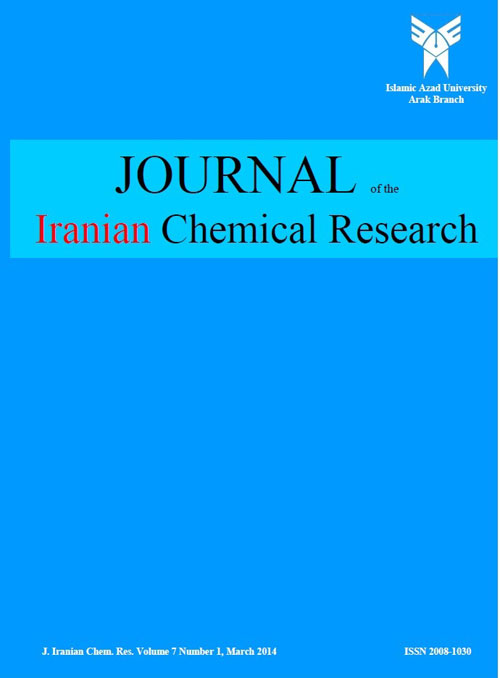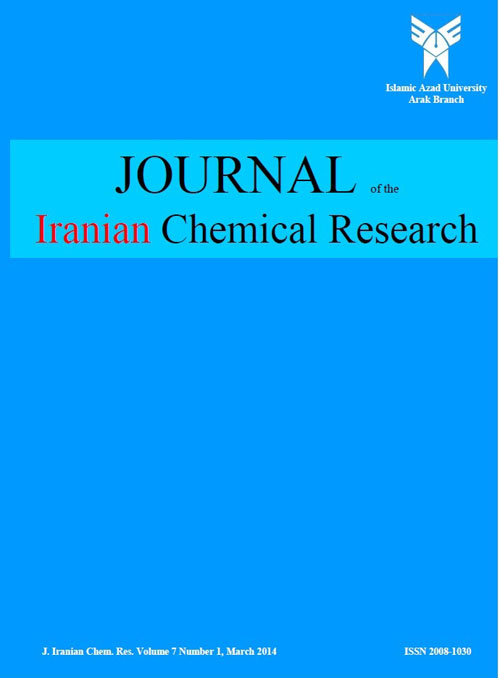فهرست مطالب

Journal of the Iranian Chemical Research
Volume:5 Issue: 3, Summer 2012
- تاریخ انتشار: 1391/06/30
- تعداد عناوین: 8
-
Pages 129-136In this work, benzyl alcohol was obtained in 96% excellent yield by hydrolysis of benzyl chloride catalyzed by the recyclable temperature-dependant phase-separation system that comprised the ionic liquid PEG1000-DAIL[BF4], toluene and ferric sulfate under homogeneous catalysis in aqueous media. This novel method not only enhanced the yield, but also made the operating units easy workup. The catalytic system can be recycled or reused without any significant loss of catalytic activity. The mechanism of hydrolysis reaction and the process of catalysis in the thermoregulated ionic liquid bi-phase system were also proposed.Keywords: Benzyl alcohol, Benzyl chloride, Hydrolysis, Thermoregulated ionic liquid biphasic system
-
Pages 137-142Nano-SbCl5.SiO2 and SbCl5.SiO2 are bench-top catalysts which are reusable, readily available, versatile and efficient for promotion of many acid catalyzed organic reactions. These catalysts do not need special precautions for preparation, handling or storage, and they can be stored at an ambient temperature for months without losing their catalytic activity. 4-dihydropyrimidin-2(1H)-ones(thiones) were synthesized in the presence of Nano-SbCl5.SiO2 or SbCl5.SiO2 as a reusable and efficient catalyst.Keywords: SbCl5.?SiO2, Biginelli reaction, Aldehyde, 3, 4, dihydropyrimidin, 2(1H), ones, 3, 4 dihydropyrimidin, 2(1H), thiones
-
Pages 143-153In this study, we present the work on the physicochemical interaction between the anti-cancer alkaloid berberine (BRB) and DNA with the purpose of designing drugs that interact more with DNA. Molecular modeling on the complex formed between berberine and DNA presented that this complex was undeniably fully able of participating in the formation of a stable intercalation site. Besides, the molecular geometries of berberine and the DNA bases (Adenine, Guanine, Cytosine and Thymine) were optimized with the aid of the B3LYP/6-31G method. This intercalator has a large polarizability and is a good electron acceptor, while base pairs are good electron donors. B3LYP/6-31G stabilization energies of intercalator DNA base pair complexes are large (-7.65 kcal/mol for AT···BRB and -3.58 kcal/mol for GC···BRB). It was eventually concluded that the dispersion energy and the electrostatic interaction influenced the stability of the intercalator···DNA base pair complexes. The results exhibited that the BRB changes affected the DNA structure with reference to the bond length, the bond angle, the torsion angle and the charges.Keywords: DNA, Intercalator, Berberine, Density functional theory
-
Pages 155-159A simple, mild and efficient method for the regioselective nitration of various aromatic compounds using poly(4-vinylpyridinium nitrate) (P4VPyN) in the presence of melamine trisulfonic acid (MTSA), is reported.
This method provides several advantages such as good selectiveity between ortho and para positions of aromatic compounds, clean procedure, simple work-up, short reaction times, solvent-free conditions and high yields of products. This methodology is useful for nitration of activated and deactivated aromatic rings.Keywords: Melamine trisulfonic acid, Nitration, Aromatic compounds -
Pages 161-171The conducting polymer films have been widely applied in the field of electrochemistry owing to their good stability, permselectivity, unique physical and chemical properties. A novel nano-Au/poly (4-aminobenzoic acid) (PABA) film modified carbon paste electrode was fabricated for sensitive detection of acetaminophen in this paper. The PABA film and nano-Au/PABA film were characterized by scanning electron microscope.
The nano-Au/PABA film exhibited obviously catalytic performance to the determination of acetaminophen with a high sensitivity and a wide linear range. Under optimum conditions (pH, the concentration of 4-aminobenzoic acid, electro-polymerization cycles), linearity between the oxidation peak current and the acetaminophen concentration was obtained in the range of 1.0 × 107 8.0 × 105 mol L-1 with a detection limit of 8.0 × 108 mol L-1 (S/N = 3). In addition, the nano-Au/PABA film modified electrode was successfully employed to determine the acetaminophen in commercial drugs, and this work has shed some doubt on the redox mechanism of acetaminophen at the sensor.Keywords: Poly (4, aminobenzoic acid), Nano, Au, Electrocatalysis, Acetaminophen -
Pages 173-176A mild and efficient method for the oxidative coupling of thiols by trimethylammonium fluorochromate (TriMFC) in solution is reported. Trimethylammonium fluorochromate is efficient and new reagent, which prepares easily and oxidizes thiols to the corresponding disulfides quickly. The reactions perform cleanly and controlled to stop at the disulfide stage without over-oxidation side products.Keywords: Trimethylammonium fluorochromate(VI), Heterogeneous oxidants, Silica gel, oxidation
-
Pages 177-185Toxicity of 38 aliphatic carboxylic acids was studied using non-linear quantitative structure-toxicity relationship (QSTR) models. The adaptive neuro-fuzzy inference system (ANFIS) was used to construct the nonlinear QSTR models in all stages of study. Two ANFIS models were developed based upon different subsets of descriptors. The first one used log ow K and LUMO E as inputs and had good prediction ability; for the training set of 28 compounds 2 Training R was 0.86 and for the test set of 10 compounds, the corresponding statistic was 2 Test R =0.97. Two outliers were detected for this ANFIS model and removing them improved the quality of the model. Another ANFIS model was constructed based on PEOE_VSA_FPNEG and G3u descriptors chosen by exhaustive search of all two combinations of calculated descriptors by Dragon and MOE softwares. The later ANFIS model showed better performance than the former ( 2 Training R =0.92 and 2 Test R =0.90) and no outlier was detected.Keywords: Quantitative, structure, activity relationship, Adaptive neuro, fuzzy inference system, Aliphatic carboxylic acids, toxicity, Tetrahymena pyriformis
-
Pages 187-195The Series of 3-(Substitutedphenyl)-N-(4H-1,2,4-triazol-4-yl)acrylamide compounds were prepared by reaction of 4-amino-1,2,4-Triazole with Acetyl Chloride followed by Claisen-Schmidt Condensation reaction with different aromatic aldehydes. The structures of new compounds were confirmed by IR, 1H-NMR and 13C-NMR spectral data. Anti-bacterial and Anti-fungal activities were evaluated and compared with the standard drugs, some compounds of the series exhibited promising anti-microbial and anti-fungal activity compared to standard drugs.Keywords: triazole, Chalcone, Antibacterial, antifungal


